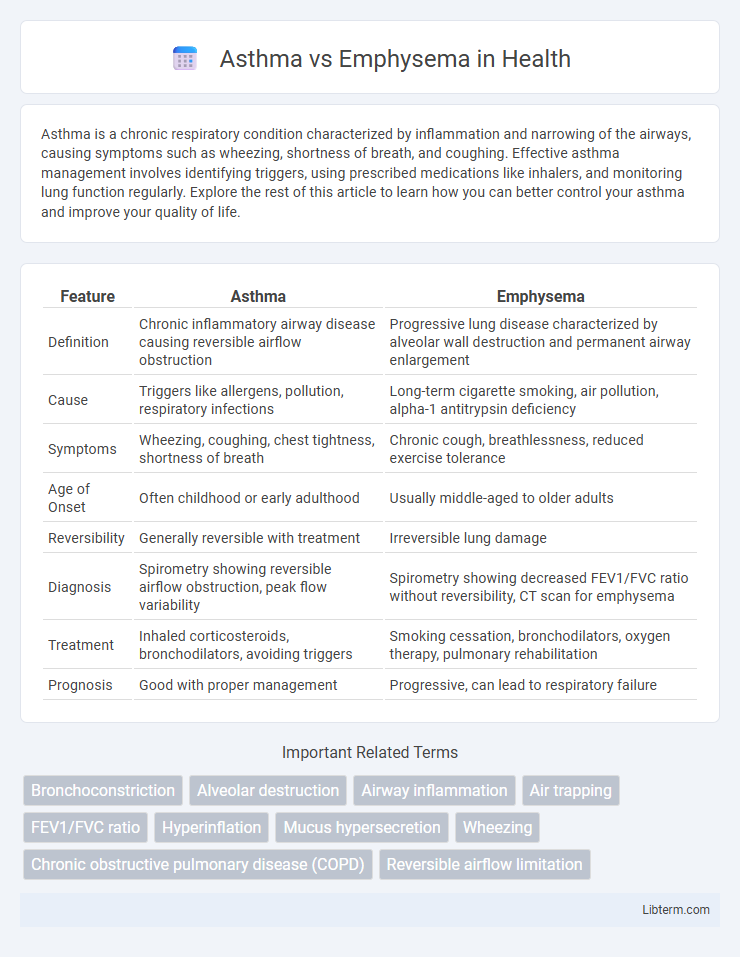Asthma is a chronic respiratory condition characterized by inflammation and narrowing of the airways, causing symptoms such as wheezing, shortness of breath, and coughing. Effective asthma management involves identifying triggers, using prescribed medications like inhalers, and monitoring lung function regularly. Explore the rest of this article to learn how you can better control your asthma and improve your quality of life.
Table of Comparison
| Feature | Asthma | Emphysema |
|---|---|---|
| Definition | Chronic inflammatory airway disease causing reversible airflow obstruction | Progressive lung disease characterized by alveolar wall destruction and permanent airway enlargement |
| Cause | Triggers like allergens, pollution, respiratory infections | Long-term cigarette smoking, air pollution, alpha-1 antitrypsin deficiency |
| Symptoms | Wheezing, coughing, chest tightness, shortness of breath | Chronic cough, breathlessness, reduced exercise tolerance |
| Age of Onset | Often childhood or early adulthood | Usually middle-aged to older adults |
| Reversibility | Generally reversible with treatment | Irreversible lung damage |
| Diagnosis | Spirometry showing reversible airflow obstruction, peak flow variability | Spirometry showing decreased FEV1/FVC ratio without reversibility, CT scan for emphysema |
| Treatment | Inhaled corticosteroids, bronchodilators, avoiding triggers | Smoking cessation, bronchodilators, oxygen therapy, pulmonary rehabilitation |
| Prognosis | Good with proper management | Progressive, can lead to respiratory failure |
Understanding Asthma and Emphysema: Key Differences
Asthma is a chronic inflammatory disease characterized by reversible airway obstruction and bronchial hyperresponsiveness, while emphysema involves permanent alveolar wall destruction leading to irreversible airflow limitation. Asthma typically presents with episodic wheezing, coughing, and shortness of breath triggered by allergens or irritants, whereas emphysema manifests as progressive dyspnea mainly due to loss of lung elasticity and impaired gas exchange. Understanding these key pathophysiological and clinical differences aids in accurate diagnosis and tailored management strategies for each condition.
Causes and Risk Factors of Asthma vs Emphysema
Asthma is primarily caused by genetic factors, environmental allergens like pollen, dust mites, and pet dander, as well as respiratory infections and air pollution, which trigger airway inflammation and hyperresponsiveness. Emphysema, a type of chronic obstructive pulmonary disease (COPD), is mainly caused by long-term exposure to cigarette smoke, air pollutants, and occupational dust or chemical fumes that damage lung tissue. Risk factors for asthma include family history, atopy, and exposure to tobacco smoke during childhood, while emphysema risk factors emphasize smoking history, advanced age, and alpha-1 antitrypsin deficiency.
Symptoms Comparison: Asthma and Emphysema
Asthma symptoms primarily include wheezing, shortness of breath, chest tightness, and coughing, often triggered by allergens or exercise. Emphysema symptoms consist of chronic shortness of breath, especially during physical activity, persistent cough, and reduced lung elasticity due to alveolar damage. Both conditions cause breathing difficulties but differ in symptom triggers and lung tissue involvement.
Diagnostic Processes for Asthma and Emphysema
Diagnostic processes for asthma involve spirometry to measure airflow obstruction and reversibility after bronchodilator use, alongside peak expiratory flow monitoring and allergy testing to identify triggers. Emphysema diagnosis relies on chest X-rays and high-resolution CT scans to detect lung tissue damage, combined with pulmonary function tests that reveal decreased lung elasticity and gas exchange efficiency. Arterial blood gas analysis may further assess oxygen and carbon dioxide levels for emphysema severity evaluation.
Triggers and Exacerbating Factors
Asthma triggers commonly include allergens such as pollen, dust mites, pet dander, and airborne irritants like smoke or strong odors, alongside respiratory infections and physical exertion. Emphysema exacerbating factors primarily revolve around prolonged exposure to cigarette smoke, air pollution, and occupational dust or chemical fumes that damage lung tissue. Both conditions worsen with respiratory infections and environmental pollutants but differ in their underlying mechanisms and response to triggers.
Lung Function in Asthma vs Emphysema
Asthma is characterized by reversible airway obstruction due to bronchial hyperresponsiveness and inflammation, leading to intermittent airflow limitation and bronchoconstriction. Emphysema involves irreversible destruction of alveolar walls and loss of elastic recoil, resulting in permanent airflow limitation and impaired gas exchange. Lung function tests in asthma typically show variability with improved forced expiratory volume (FEV1) after bronchodilator use, whereas emphysema exhibits a reduced FEV1 to forced vital capacity (FVC) ratio that does not significantly improve with bronchodilators.
Treatment Approaches: Asthma and Emphysema
Asthma treatment focuses on inhaled corticosteroids and bronchodilators to reduce airway inflammation and improve breathing, often including long-term control and quick-relief medications. Emphysema management primarily involves smoking cessation, supplemental oxygen therapy, and bronchodilators to enhance lung function and slow disease progression. Pulmonary rehabilitation and lifestyle modifications are critical for both conditions to optimize respiratory health and patient quality of life.
Prognosis and Life Expectancy Differences
Asthma typically has a better prognosis with proper management, allowing many patients to lead normal lives, while emphysema, a form of chronic obstructive pulmonary disease (COPD), often results in progressive lung damage and reduced life expectancy. Life expectancy in emphysema patients is significantly shorter, especially in cases related to smoking, with median survival ranging from 5 to 10 years after diagnosis compared to near-normal expectancy in well-controlled asthma. Early diagnosis and treatment improve outcomes in asthma, whereas emphysema prognosis worsens with advancing disease severity and frequent exacerbations.
Prevention Strategies for Asthma and Emphysema
Effective prevention strategies for asthma emphasize reducing exposure to allergens, pollutants, and tobacco smoke, alongside maintaining good indoor air quality with regular cleaning. Emphysema prevention primarily focuses on avoiding cigarette smoke, minimizing exposure to air pollutants, and encouraging smoking cessation programs to reduce lung damage. Both conditions benefit from promoting vaccinations against respiratory infections like influenza and pneumonia to prevent exacerbations.
Living with Asthma or Emphysema: Quality of Life
Living with asthma requires careful management of triggers and adherence to inhaler use to maintain optimal lung function and prevent attacks. Emphysema, a form of chronic obstructive pulmonary disease (COPD), demands ongoing oxygen therapy and lifestyle adjustments to improve breathing and reduce symptom severity. Both conditions significantly impact quality of life, making proactive medical care and support essential for daily functioning and well-being.
Asthma Infographic

 libterm.com
libterm.com